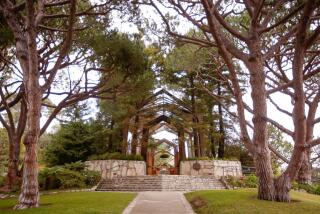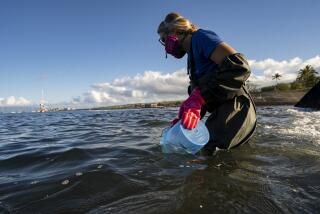Easter Island has stone heads, but little else. What happened?
Most everyone is familiar with the enigmatic stone heads of Easter Island, the massive carved rocks that sit on stone platforms on the coast and lie scattered across the landscape.
The heads, called moai, and a small native population are virtually all that is left of the Polynesian civilization that once flourished on the island. The once-lush forests that covered the 63-square-mile island, known to its inhabitants as Rapa Nui, have all been lost and the fertile soil that once supported a vital farming community has been blown away by tradewinds.
Something else has been left behind: two great mysteries. How did the islanders manage to transfer the massive heads, some weighing as much as 80 tons, from the quarries to the shore, and what happened to the forests? This month’s National Geographic magazine examines the two competing theories for each of those questions.
UCLA anthropologist Jared Diamond famously detailed what the called the “ecocide” of Rapa Nui in his 2005 book “Collapse.” When Polynesians first settled the island about AD 800, they had the misfortune to select one that was dry, cool and remote -- and thus poorly fertilized by windblown dust or volcanic ash. They chopped down forests to provide wood for construction and for moving the moai, and the trees didn’t return. The denuded landscape allowed winds to blow off the topsoil, and fertility fell sharply. When the natives no longer had wood for building fishing canoes, they killed and ate all the birds. Before the Dutch arrived at the island on Easter Sunday in 1722, the population had descended into cannibalism and barbarity. Diamond called it “the clearest example of a society that destroyed itself by over-exploiting its own resources.”
But archaeologists Carl Lipo of Cal State Long Beach and Terry Hunt of the University of Hawaii have a different take on the events based on more recent research. They agree that the island was an ecological disaster, but argue that the inhabitants share a smaller portion of the blame. Their research indicates that the Polynesian settlers did not arrive at Rapa Nui until about AD 1200, which would not leave nearly enough time to devastate the forests solely by slashing and burning.
Unfortunately, the settlers brought Polynesian rats with them. The first inhabitants dined on the rats, but the animals had no other natural predators and overran the island. Buried nuts from the extinct Easter Island palms show distinctive teethmarks from the rats. They probably also ate birds’ eggs. With the rats eating the palm nuts, the trees could not be reseeded naturally, Lipo and Hunt argue in their recent book, “The Statues That Walked,” and the forests disappeared.
The stone for the moai came from a quarry at Rano Raraku, the island’s southeastern (extinct) volcano, several miles from the coast. Diamond and others have argued that the inhabitants put the moai on wooden sledges and dragged them to the shore on wooden rails -- an effort that would have required both large amounts of labor and massive quantities of wood. Last year, however, Hunt and Lipo showed that the stones could be “walked” by as few as 18 people with ropes by tilting them back and forth on their bases. That version jibes well with the islanders’ own mythology, which claims that the moai walked across the island.
The island is now a part of Chile and its 5,000 inhabitants are vastly outnumbered by the 50,000 tourists who visit each year. All food, fuel and other necessities have to be flown or shipped in, and water supplies are growing scarce. Residents worry about the future and how long the economy can survive in its present condition. The past is grim. The future might be grimmer.
A documentary about the island will appear on “Nova” in November.
LATimesScience@gmail.com
Twitter/@LATMaugh






